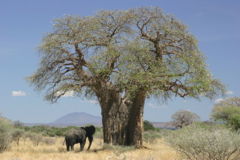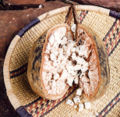Adansonia digitata
Adansonia digitata {{{latin_name}}}
|
'
| ||||||||||||||||||||||||||||||||||||||||
|---|---|---|---|---|---|---|---|---|---|---|---|---|---|---|---|---|---|---|---|---|---|---|---|---|---|---|---|---|---|---|---|---|---|---|---|---|---|---|---|---|---|

|
|
| |||||||||||||||||||||||||||||||||||||||
| |||||||||||||||||||||||||||||||||||||||||
| Standard Cyclopedia of Horticulture |
|---|
|
Adansonia digitata, Linn. Baobab Tree. Figs. 118, 119. Height not more than 60 ft.: diam. said to be sometimes 30 ft. or more and to have the thickest trunk of any tree in the world: lvs. palmate, with 3 lfts. in young plants, and 5-7 in older ones: fls. 6 in. across, with purplish anthers, on long axillary, solitary peduncles; stigma 7-10-rayed in full anthesis. Afr. B.M. 2791- 2792. G.C. III. 27:57.—Rarely cult, in extreme S. Fla., where fr. is 9-12 in. long, and called "monkey's bread." Figs. 118 and 119 are from specimens growing in the American tropics. The fl. opens wide, something like a spreading hibiscus, and the petals soon roll back and wither, as shown in Fig. 119. The tree is very thick-boled, and the wood is soft and light. The tree is supposed to attain to vast age. The fr. of the baobab is a gourd-like structure, of which the pulp is said sometimes to be eaten and the juice used for the making of a beverage. The bark produces a very strong fiber.CH
|
Cultivation
- Do you have cultivation info on this plant? Edit this section!
Propagation
- Do you have propagation info on this plant? Edit this section!
Pests and diseases
- Do you have pest and disease info on this plant? Edit this section!
Species
Gallery
-
The fruit can be up to 25 cm long and can be used to make a drink -
Leaves and fruit of Adansonia digitata -
Baobab Tree by Thomas Baines -
Baobab flower
References
- Standard Cyclopedia of Horticulture, by L. H. Bailey, MacMillan Co., 1963
External links
- w:Adansonia digitata. Some of the material on this page may be from Wikipedia, under the Creative Commons license.
- Adansonia digitata QR Code (Size 50, 100, 200, 500)



